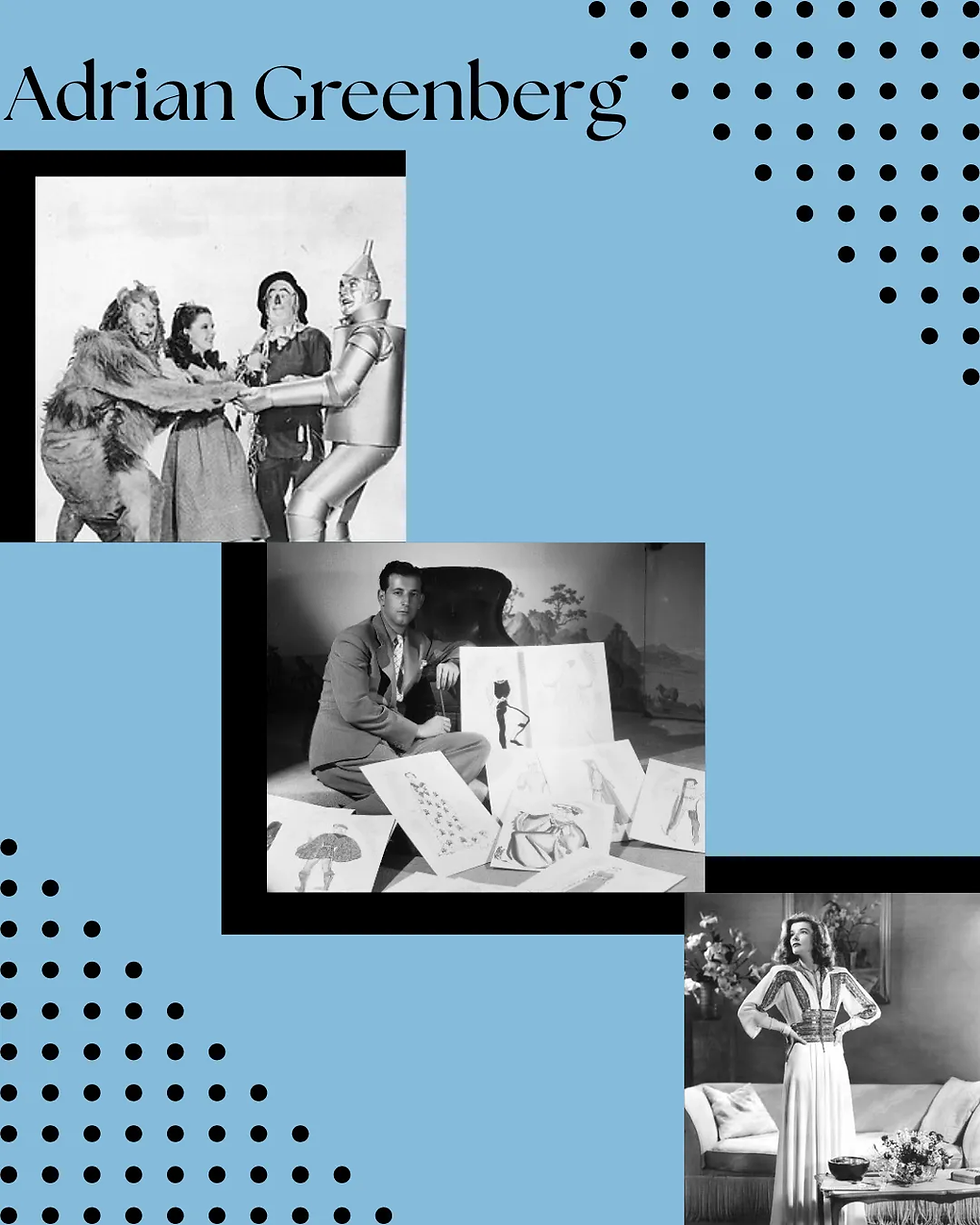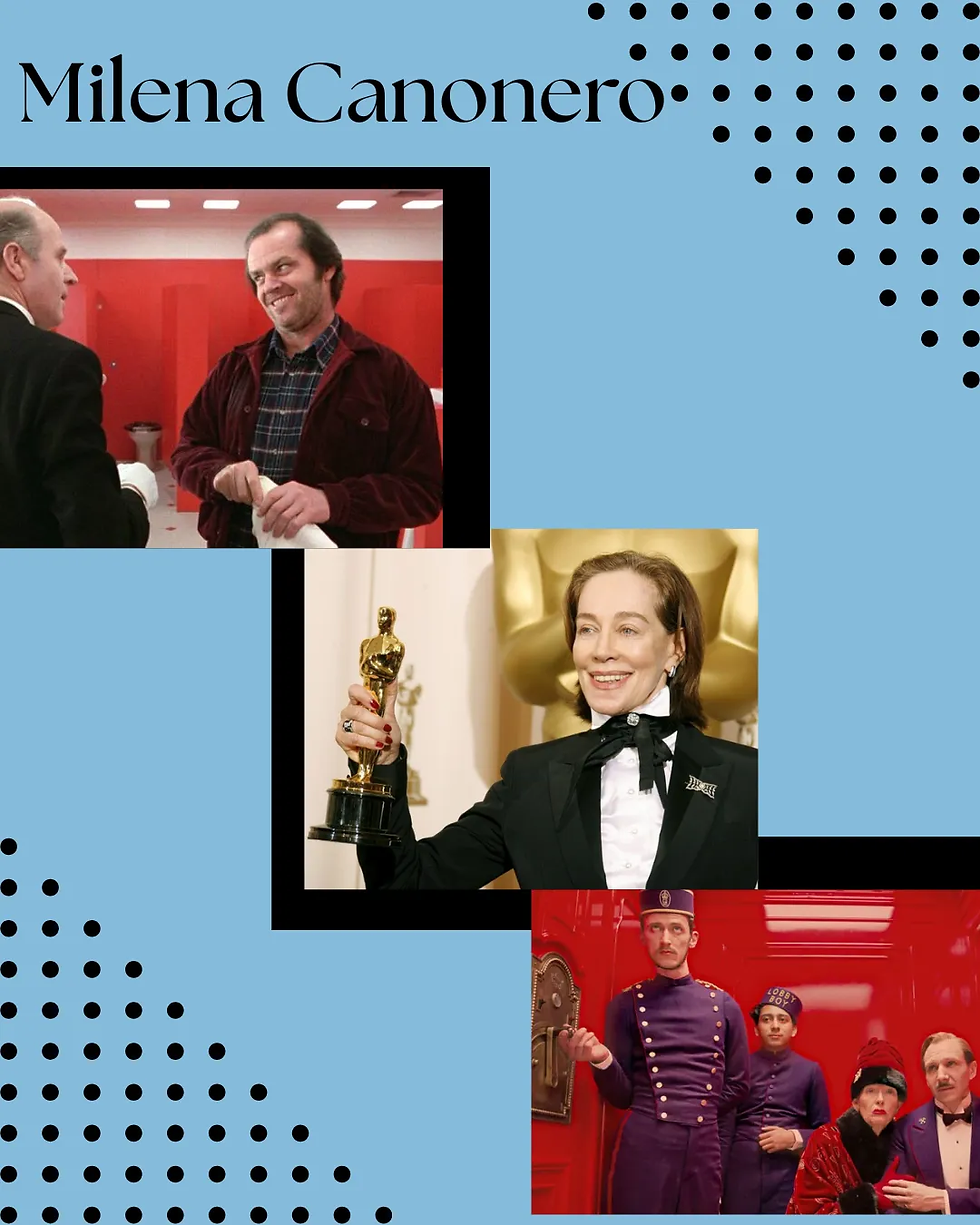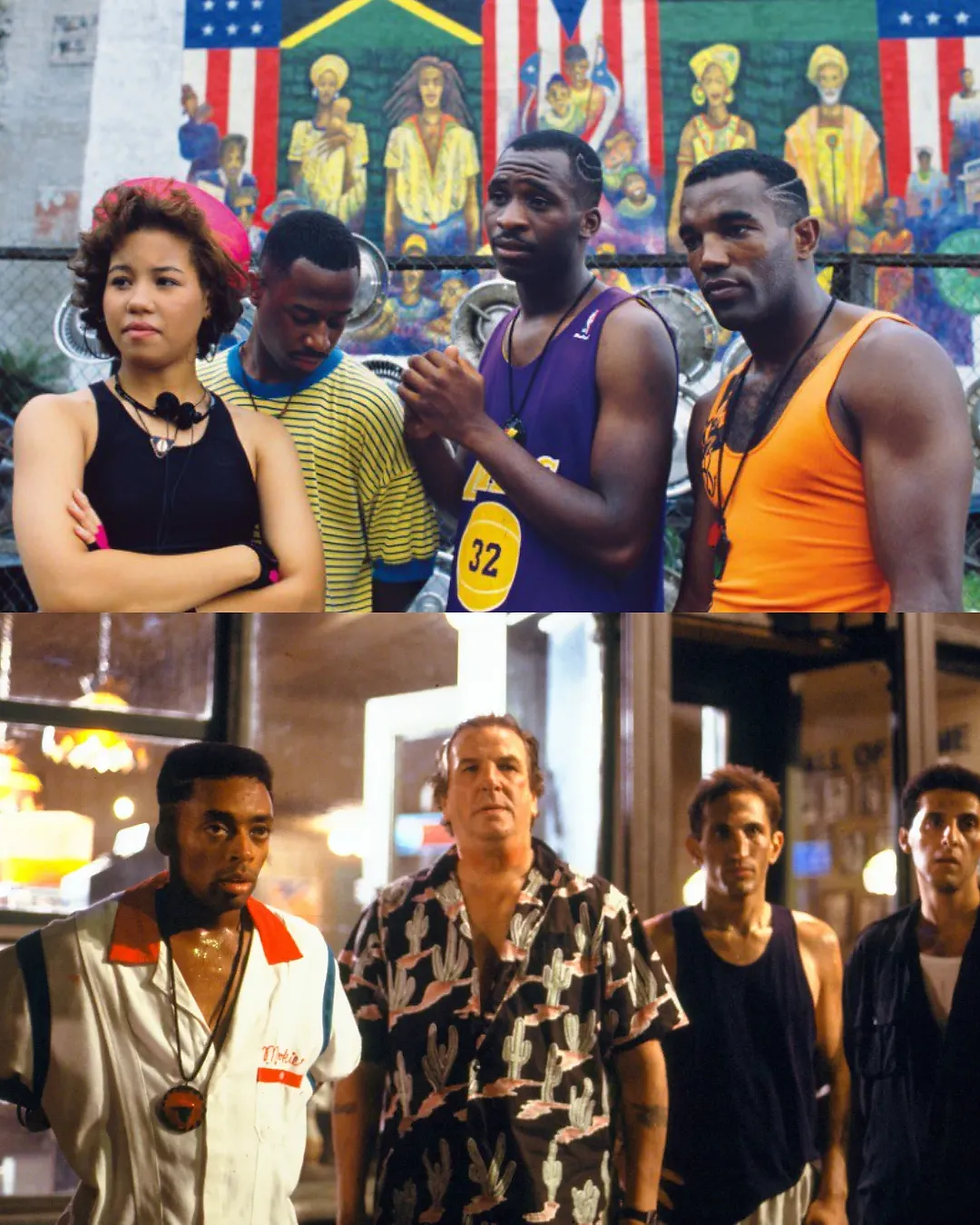Weekly Listicle: Fabulous Costume Designers throughout History
- Tina Ter-Akopyan
- Jun 4
- 6 min read

When I watch a film, the first thing I tend to observe about a character is how they dress. Although we are told not to judge a book by its cover, a character’s costume design immediately communicates their personality and how they want the world to perceive them. Whether it’s recreating historical time periods or developing new and fantastical worlds through garments, costume designers play a key role in immersing audiences into a story and fleshing out characters.
However, it was not until the 1940s that costume design became integrated into the filmmaking process and was awarded as a technical craft at the Oscars. Before costume designers were established as principal creatives on set, actors were expected to use their own wardrobes to dress their characters. In many cases, the actors with the best wardrobes were often favored for the role. As the filmmaking business grew, costume design became associated with the glamour and glitz of Hollywood stardom.
Let’s take a look at some legendary costume designers that have shaped the cultural impact of film through their designs.
1. Adrian Greenberg

Adrian Greenberg was one of the first costume designers of the studio system era. He created dresses that transcended the screen and influenced the style and poise of American society. The chief costume designer for MGM Studios, Adrian designed gowns for iconic leading ladies, such as Joan Crawford in her big shoulder pad suits or Katherine Hepburn in her elegant yet sporty dresses.
While Adrian styled countless actresses on over 250 films, he is most well-remembered for his work on The Wizard of Oz (1939), where he made the defining piece of his career: the ruby red slippers. Deviating from Frank Baum’s novel, where Dorothy’s shoes are sliver, Adrian settled on ruby red for the color so they would stand out on the Technicolor screen. Placing over 2,300 sequins on the shoes, Adrian handcrafted one of the most recognizable artifacts of Hollywood history.

2. Edith Head

With her distinctive bangs, round shaped glasses, and short stature, Edith Head is the leading image of a Hollywood costume designer (her famous look even inspired the design of the Edna Mode in The Incredibles (2004)). With eight Oscars, setting the record for the most wins for any woman, Head lead an entire era of Hollywood fashion through her collaboration with the top-tier directors and actors.
Fearless, intelligent, and direct, Head knew how to communicate and represent the director’s visions while also tailoring costumes to complement the complexions and needs of the actors she styled. She wanted her costumes to emulate a sense of fantasy that was “a cross between camouflage and magic.”
Throughout the span of her fifty-year career, Head was responsible for legendary costumes that have graced the screen. Her most influential looks have come from styling Audrey Hepburn and Grace Kelly during the beginnings of their stardom. From the playful skirt suit combo Hepburn wears in Roman Holiday (1953) to the beautiful black and white maxi dress Kelly wears in Rear Window (1954), Head understood how to pair these beautiful actresses with the right fabrics and colors that matched their characters and their personality.

3. Piero Gherardi

Italian costume designer Piero Gherardi introduced a new level of sophistication and modernism to costume design through his collaboration with Federico Fellini in the 1960s. Working as both a production and costume designer, Gherardi had a particular understanding of how costumes fit within the entire visual tone of a film. Since most of the films Gherardi worked on were black-and-white, he also learned how to use a limited color palette to create simple yet bold costumes. Designing costumes primarily for Fellini’s stylish and abstract films, Gherardi helped develop the foundation of a daring new era of European filmmaking.
Gherardi’s most recognizable and influential work appears in Fellini’s masterpiece 8 ½ (1963), which he won Best Costume Design for at the Oscars. Gherardi exemplified the suave and charismatic nature of Marcello Mastroianni by designing his signature black Neapolitan suite paired with thick Prada glasses and a bowl hat. Later in the finale parade scene of the film, Gherardi brings Fellini’s playful and whimsical vision to life through the all-white dresses and suites adorned with feathers and pearls the acting ensemble wears as they dance around in circles. As Fellini alternates between memories, dreams, and reality, Gherardi integrated subtle changes in each costume to communicate these shifts.

Anthea Sylbert

Anthea Sylbert worked on some of the most famous films coming out during the New Wave in Hollywood from horror thrillers like Rosemary’s Baby (1968), to comedies, like Shampoo (1975). Sylbert had a great talent in immersing audiences into the diverse worlds she had to design through her detailed and timely costumes.
Paired up with her husband and production designer Richard Sylbert, the duo worked hand-in-hand to establish the visual tone of the film Chinatown (1972). Sylbert crafted costumes that were not only historically accurate to 1930s Los Angeles but also matched the sun drenched and dark tones of this film noir. Sylbert saw the character’s bold and tailored suites as the armor they used to cover up their insecurities and pasts. For Jake Gittes, played memorably by Jack Nicholson, Anthea specifically researched dandy fashion and heightened the colors and dimensions of his suit to complement Jake’s charisma. Looking back upon her career, Sylbert mentioned how Nicholson gave her one of “the best compliments,” when he said: “When The Ant [his nickname for her] does your clothes, you don’t have to act as much.”
After working as a costume designer for twenty more years and earning two Oscar nominations, Sylbert pivoted and became a studio executive at Warner Bros. and later a producer.

Milena Canonero

Italian costume designer Milena Canonero has worked with monumental directors over the course of her fifty-year career and won four Academy Awards. Canonero’s designs have no limit, as she has created costumes for various genres like period pieces (Sofia Coppola’s Marie Antionette (2006) ) and superhero crime films (Warren Beatty’s Dick Tracy (1990) ). Her most notable collaboration, however, was with director Stanley Kubrick. With keen eye for color and a focus on mixing modern and vintage styles together, Canonero’s costumes have a distinctive style that enhance the vision of the directors she works with.
In The Shining (1980), Canonero brought Kubrick’s wild imagination to life. Canonero focused on designing pieces that matched the eerily symmetrical visual style Kubrick creates in the film. Canonero paid close attention to how the colors and patterns of the characters’ costumes fits within the abandoned and isolated geography of The Overlook Hotel. For instance, Canonero and Kubrick showcase an unusual connection between Jack Torrance (played by Jack Nicholson) and the hotel when an extreme close-up of his green tie reveals how the pattern exactly matches the hotel maze’s pattern. As the movie progresses, the costumes, such as the blue doll dresses of the Grady twins and the infamous bear suit, help conjure a sense of unease. The disparity between the normal middle-class American look of the Torrance family and the costumes of the hotel occupants further blurs the lines between fantasy and reality in the film.
Today, Canonero closely collaborates director Wes Anderson, and most recently, designed the costumes for his film The Phoenician Scheme.

Ruth E. Carter

Ruth E. Carter has established herself as a groundbreaking and visionary costume designer during her thirty-year career working with directors like Spike Lee and Ryan Coogler. A two-time Oscar winner for her work on the Black Panther franchise, Carter became the first African American to win the Best Costume Designer award as well as first African-American woman to win multiple awards in any category. Carter showcased the artistry, research, and imagination that goes into creating the costumes for a superhero film. To develop an entirely new and innovative design for the film, Carter merged the style of Afrofuturism with the cultural history of Africa.
While Carter is most recognized for her work on Black Panther (2018), she showed her early talents in one of her first films Do the Right Thing (1989). Collaborating with director Spike Lee, Carter focused on capturing the cultural specificity of the neighborhood as well as reflecting the unbearable heat of the city. Carter integrated African cloths and fabrics into the streetwear of the characters to represent the cultural fusion within the community. Designing memorable pieces, such as Radio Raheem's "Bed-Stuy Do or Die" T-shirt and Mookie’s oversized Sal’s Pizzeria shirt, Carter represented the vibrant and proud attitudes of the characters in the neighborhood.
When crafting costumes, Carter always reminds herself that “the costumes didn’t wear the actor; the actor wore them,” meaning that the costumes should never overpower or drown the character. Instead, she wants the actors to feel as if the costumes blend with the personality of the characters they are representing.

We often form an emotional connection and admiration for our favorite film characters based on their costumes and appearances. Without costume designers, the personality and specificity of our favorite films and characters would be non-existent.




